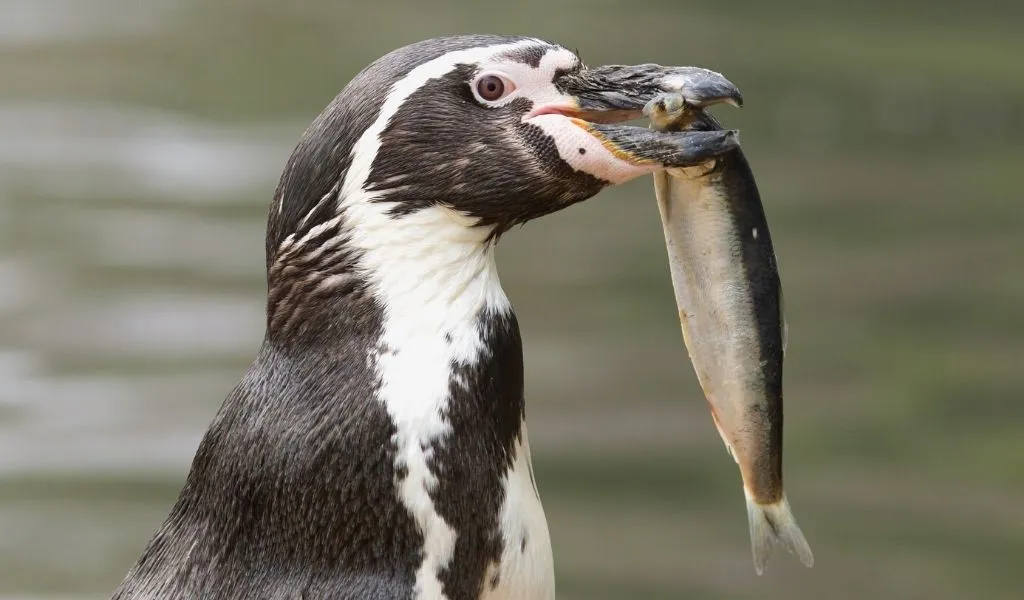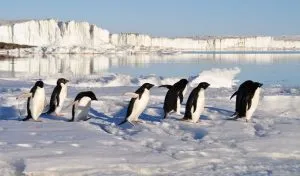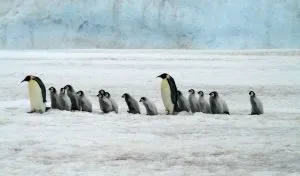Penguins can be found in some of the most remote and extreme places in the southern hemisphere where you won’t even find a McDonalds, at least not just yet. So, what do penguins eat?
Penguins are carnivores because they mostly eat fish, squid, and small crustaceans such as krill. They feed at sea by catching prey in their beaks and swallowing it whole. A penguin eats between 1-3kg of food per day, although they increase this when preparing to fast or feeding their young.
Keep reading for some more facts about penguins, such as their feeding habits, how their diet differs between species, and how they regurgitate food to feed their offspring.
Are Penguins Carnivore?
Yes, penguins are carnivores which means they only eat other animals. This is the opposite of herbivores which only eat plants.
Some scientists refer to African Penguins as a piscivore since their diet is primarily fish1 (source: A.M. McInnes, et al., Royal Society Open Science, Vol. 4, 2017), although they also eat mollusks such as squid. Fossils of a giant penguin in Antarctica suggest that ancestors of the modern penguin were also piscivores with strong diving abilities2 (source: C.A. Hospitaleche, Comptes Rendus Palevol, Vol. 13, Issue 7, 2014).
What Do Penguins Eat?
So, we’ve all heard the penguin joke that they eat ice berg-ers, but what do these tuxedo-wearing birds really eat?
Penguins eat fish, squid, and krill. However, they are opportunistic hunters and will adapt their diet to whatever is available. A penguin’s diet can vary between species and even among different populations of the same species.
For example, Southern Rockhopper Penguins in Macquarie Island make up about 70% of their diet with Krill and 17% fish, whereas those on neighboring Campbell Island (around 700km away) most eat fish3 (source: P.D. Boersma and P.G. Borboroglu, Penguins: Natural History and Conservation, 2013).
Let’s look at the three main prey:
1. Crustaceans (Mainly Krill)
Most penguins eat crustaceans as part of their diet, with krill being the most popular.
Krill are small shrimp-like crustaceans that can be found in all oceans across the world. There are more than 80 different krill species that vary in size between 8 to 60mm4 (source: Britannica).
Penguins outside of Antarctica and larger species (such as King and Emperor Penguins) consume krill as part of a wider diet, including squid and small fish. However, smaller Antarctic species such as Chinstrap and Adelie Penguins are heavily reliant on krill which feeds on algae found under the Antarctic ice5 (source: P.D. Boersma and P.G. Borboroglu, Penguins: Natural History and Conservation, 2013). The numbers of these species are closely linked to krill availability.
Penguins compete with other predators such as seals and whales, for krill. This is why there was a near five-fold increase in Adelie and Chinstrap Penguin populations between 1930-1970 when whaling was prominent as fewer whales meant more krill for the penguins6 (source: BBC).
However, melting sea ice caused by climate change and the growing predator seal and whale populations are now harming the Antarctic krill population. This is having a knock-on effect among these penguin species which are now declining.
As well as krill, penguins also eat other crustaceans where they are available such as amphipods, isopods, and stomatopods7 (source: R. Wilson, et al., Journal of Ornithology, Vol. 130, No. 1, 1989).
2. Cephalopods (Mainly Squid)
Some species of penguin eat cephalopods, a type of mollusk. The main cephalopods eaten by penguins are squid, including arrow squid, Patagonian squid, Humboldt squid, and more8 (source: P.D. Boersma and P.G. Borboroglu, Penguins: Natural History and Conservation, 2013).
King and Adelie Penguins change their diet throughout the year, increasing consumption of squid in winter when their other prey may be less abundant. This is in comparison to other species where some species, including many crested penguins, consume it as part of their regular year-round diet.
Fiordland Penguins are reported to have a diet that’s made up of 85% arrow squid. In comparison, King Penguins prey almost exclusively on lanternfish, although in the winter when the supply is more difficult, they may switch part of their diet to squid9 (source: Y. Cherel, et al., Marine Biology, Vol. 126, Issue 4, 1996).
Up until around 200 years ago, Adelie Penguins had thrived on a diet of fish. However, krill availability went through the roof during the commercial whaling boom when most of their predators were killed off. This lead Adelie Penguins to switch to the more abundant prey and it now makes up most of their diet10 (source: H. Ledford, Nature, 2007).
3. Small Fish
Some types of penguins, typically larger species or those that forage further north, also consume smaller fish. The type of fish eaten by penguins will vary between species and foraging location but can include Antarctic silverfish, lanternfish, anchovy, pilchard, sprat, cod, silverside, marcel, mullet, sardine, and goby. See below for a breakdown of which fish is eaten by which species.
Penguin Diet By Species
Here is a table that breaks down the key diet of each species, although keep in mind that it can be different depending upon where they forage.
| Penguin Species | Genus (Sub-Group) | Diet |
|---|---|---|
| Emperor Penguin | Aptenodytes (great penguins) | Fish (antarctic silverfish), squid (arrow squid), and crustaceans (krill) |
| King Penguin | Aptenodytes (great penguins) | Mostly fish (lanternfish) but also squid in winter |
| Royal Penguin | Eudyptes (crested penguins) | Fish, squid, and crustaceans (krill) |
| Fiordland Penguin | Eudyptes (crested penguins) | Mostly squid (arrow squid) |
| Snares Penguin | Eudyptes (crested penguins) | Fish (lanternfish, pipefish), squid, and crustaceans |
| Macaroni Penguin | Eudyptes (crested penguins) | Fish (lanternfish) and crustaceans (krill, amphipods) with some squid |
| Erect-crested Penguin | Eudyptes (crested penguins) | Fish, squid, and crustaceans (krill) |
| Northern Rockhopper Penguin | Eudyptes (crested penguins) | Fish, squid, and crustaceans |
| Southern Rockhopper Penguin | Eudyptes (crested penguins) | Fish, squid, and crustaceans (krill) |
| Little Penguin | Eudyptula (little penguins) | Mostly fish (anchovy, pilchards, sprat) but also squid and crustaceans (krill) |
| Yellow-eyed Penguin | Megadyptes | Fish (sprat, cod) and squid |
| Adelie Penguin | Pygoscelis (brush-tailed penguins) | Mostly fish (silverfish) and crustaceans (krill, amphipods) but also squid |
| Chinstrap Penguin | Pygoscelis (brush-tailed penguins) | Mostly crustaceans (krill) but also fish (lanternfish) |
| Gentoo Penguin | Pygoscelis (brush-tailed penguins) | Fish, squid, and crustaceans |
| Humboldt Penguin | Spheniscus (banded penguins) | Mostly fish (anchovy, silverside, macrel) but also squid and crustaceans |
| Magellanic Penguin | Spheniscus (banded penguins) | Fish, squid, and crustaceans |
| Galapagos Penguin | Spheniscus (banded penguins) | Mostly fish (anchovy, pilchard, mullet) and crustaceans |
| African Penguin | Spheniscus (banded penguins) | Mostly fish (anchovy, sardine, goby) |
How Do Penguins Eat?
Penguins catch and eat their food at sea. They will catch prey as they swim upwards and swallow it whole without chewing. They have a large, powerful tongue with spine-like bumps on the back surface to aid with catching and swallowing prey11 (source: K Kobayashi, et al., Arch Histol Cytol, 61 (1) 1998).
Like most birds, penguins do not have sweet taste receptors in their tongue, but scientists also discovered that they can’t taste umami or bitter tastes either, leaving only sour and salty tastes12 (source: H. Zhao, et al., Current Biology, Vol. 25, Issue 4, 2015).
It’s unusual for a carnivore to lack umami taste receptors as this is what gives meat its meaty flavor. However, since penguins swallow their food whole, it doesn’t make that much difference in how penguins eat.
How Much Do Penguins Eat?
When penguins are not fasting, they will forage for food in the sea every day. Although penguins are cathemeral (they can be active at day or night), most species choose to hunt in the day because they are visual hunters.
The amount of food a penguin eats will vary depending upon the species. The largest species, the Emperor Penguin, will easily eat 2-3kg per day whereas the smallest species, the Little Penguin, will eat around 1kg per day, equivalent to its own body weight13 (source: DELWP, Victoria State Government, Australia).
The amount can also vary throughout the year, for example, Emperor Penguins can easily double their food intake when they need to feed chicks or are preparing to fast14 (source: WWF).
As a total species, Macaroni Penguins consume the most food, not just compared to other penguins but out of all marine birds. It’s estimated that they consume more than 8 million tons of prey per year, mostly krill15 (source: C.M. Waluda, et al., Marine Ecology Progress Series, Vol. 466, 2012).
What Do Penguins Drink?
Penguins spend most of their lives at sea or around coastal areas where the only water available for consumption is saltwater. However, the kidney of a bird is not very efficient at processing salt, so what do they drink?
Penguins can drink saltwater due to a salt gland (also known as a superorbital gland) at the top of their skull, near their eye, which removes salt from their blood. The salt is excreted in water droplets through their nostrils by sneezing or shaking their head16 (source: Britannica).
However, penguins don’t go out of their way to chug saltwater, they consume it naturally when eating their prey. When on land, they will eat snow or drink from pools formed by melted snow to keep hydrated17 (source: H. Waters, Smithsonian Magazine, 2013).
Penguins are birds and we know that all birds have a nasal gland to some extent. However, it can be up to 100 times larger in marine birds such as penguins18 (source: K. Schmidt-Nielsen, The Salt-Secreting Gland of Marine Birds, 1960). In a study of penguins, researchers found that the size of the nasal gland was related to their diet.
Those species which have a diet with lots of marine invertebrates (krill, squid, etc) have a larger gland compared to those that eat predominately fish19 (source: S.L. Hauserman, et al., The Smithsonian Institution). This is because fish are classed as hypoosmotic (less salty than seawater) whereas marine invertebrates are isomostic (as salty as seawater).
What Do Baby Penguins Eat?
Baby penguins have a diet of regurgitated fish, squid, and crustaceans which are caught by their parents and partially digested before being regurgitated directly into the chick’s beak.
Penguin chicks must rely on their parents to provide food since their natal down (baby feathers) aren’t waterproof so they cannot forage for food in the ocean themselves.
Penguins are monogamous with both the males and females raising the offspring. Sometimes they will take it in turns to look after their young, however, they may also leave the chicks at a creche while both parents catch prey.
Penguins, like all birds, have a two-chambered stomach. The first one, the proventriculus, is used to digest the food, whereas the second one, the gizzard, is used for storing, soaking, and mechanically grinding the food20 (source: M. Olsen, et al., Polar Biology Vol. 25, 2002).
To feed their young, penguins will only partially digest some of the food they catch and store it in their gizzard for several hours. When they return to the nest, they will regurgitate the mixture directly into the chick’s beak.
If penguins need to keep the food for longer, perhaps due to a longer foraging trip, some species can store prey undigested for up to 3 weeks at a time. They produce an antibacterial agent to prevent bacteria growth and keep it fresh. Sometimes this is referred to as ‘refrigeration’21 (source: E. Young, New Scientist, 2003).
Do Penguins Swallow Stones?
Yes, when observing the stomach contents of penguins, researchers have found that at least 6 different species have swallowed stones. These are Adelie, African, Emperor, Gento, Yellow-Eyed, and Magellanic. Although some are swallowed indirectly, penguins have been observed swallowing them on purpose.
They select small 5mm stones and swallow them whole, up to 31 per bird. It is speculated that penguins swallow stones to aid in digesting the hard shells of crustaceans in their diet, to provide extra weight so that they can dive deeper, and to help them adapt to fasting22 (source: D. Beaune, Polar Biology, Vol. 32, No. 4, 2009).
Given that stones have been found in penguin chicks who don’t dive or fast, the aid of digestion is expected to be the main purpose of swallowing stones. This is called a gastrolith and is more common than you think. It’s a technique used by any animals lacking suitable grinding teeth, including crocodiles, alligators, birds, seals, and sea lions23 (source: Wikipedia).
This is not the only strange relationship penguins have with stones, they also give pebbles to partners as a courtship gesture and an acknowledgment of their relationship.
Related Questions
What Do Penguins Eat in Captivity?
Penguins in captivity will eat a diet similar to what they would consume in the wild, including fish, squid, and krill. However, the difference is that in captivity the prey would be dead or frozen rather than being caught alive in the ocean.
Do Penguins Eat Fruit?
No, penguins do not eat fruit because they are carnivores and only eat meat. However, they lack sweet taste receptors in their tongue so they would not be able to taste it anyway24 (source: H. Zhao, et al., Current Biology, Vol. 25, Issue 4, 2015).
Do Penguins Eat Seal?
No, penguins do not eat seals, it’s the opposite way around as penguins are often hunted by seals.
They will wait around near penguin colonies looking for prey. Some seals will grip the penguin by its feet and beat it against the water to remove the skin and feathers before eating it25 (source: P.D. Boersma and P.G. Borboroglu, Penguins: Natural History and Conservation, 2013).
Do Penguins Eat Shrimp?
Yes, penguins eat shrimp which are small crustaceans found in the ocean. However, they likely eat this in small quantities as their preferred crustaceans are shrimp-like krill and amphipods. Humboldt Penguins are one of the species that have been noted to eat some shrimp as part of their diet26 (source: A. Scolaro, et al., Waterbirds, Vol. 22, No. 1, 1999).
Do Penguins Eat Crab?
No, penguins do not eat crabs as a regular part of their diet, but they do eat other hard-shelled crustaceans such as krill and amphipods.
Most species of crabs would be too large for a penguin since they don’t chew their food and must swallow it whole. However, it’s possible that they eat the smaller species from time to time as they are opportunistic feeders, meaning they will eat whatever they can get hold of.
Do Penguins Eat Plankton?
Before answering this, it’s worth understanding the two types of plankton; zooplankton are small weak organisms in the ocean, and phytoplankton which are microscopic plants in the ocean. So, do penguins eat them?
Yes, penguins eat plankton, however, they only eat zooplankton such as Antarctic krill, they do not eat phytoplankton as these are plants and penguins are carnivores. Since zooplankton eat phytoplankton, it is still an important part of their food chain.
Do Penguins Eat Other Penguins?
No, there is no evidence to suggest that penguins are cannibals. However, they do engage in some outlandish behavior, for example, Adelie Penguins have been known to perform necrophilia and physical abuse27 (source: R.Mckie, The Guardian, 2012).
Do Penguins Eat Their Own Poop?
No, penguins do not eat their own poop, but they do use it in other ways. Penguin poop (known as guano) is used by some species such as Humboldt and African Penguins to build nests. They use their feet to dig burrows in the guano which can protect against predators and extreme weather28 (source: P.D. Boersma and P.G. Borboroglu, Penguins: Natural History and Conservation, 2013).
Do Penguins Eat Seaweed?
No, penguins do not eat seaweed because they are carnivores which means they do not eat plants. They only eat other animals such as fish, squid, and krill. However, seaweed is still an important part of their food chain since many of their prey feed on it.
Can You Eat Penguins?
No, although they would not be dangerous for human consumption, you cannot eat penguins to international legislation which gives them a lot of protection. In any case, research suggests that they would not taste great anyway.


![Read more about the article 14 Magnificant Facts About Magellanic Penguins [#9 Will Surprise You!]](https://polarguidebook.com/wp-content/uploads/2023/01/Magellanic-penguins-group-300x200.jpg)

